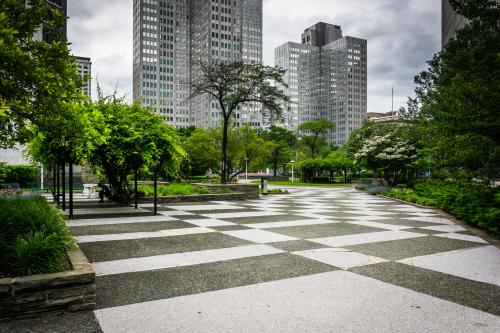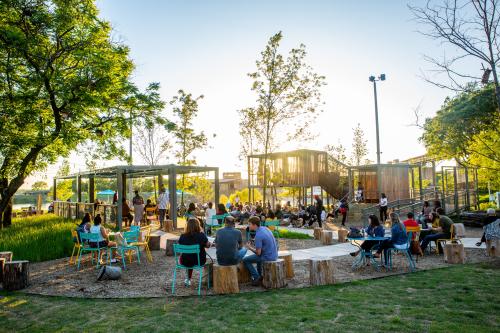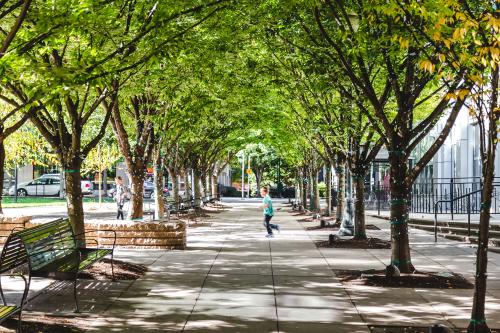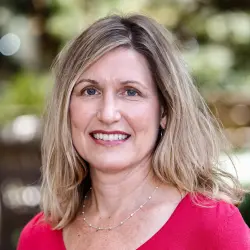Earlier this summer, activists in Washington, D.C.’s Ward 8 held two vigils on the same day—one for a pedestrian killed in a hit-and-run and the other for a young man lost to gun violence. In placing the two vigils one after another, they drew a poignant connection between the high rates of traffic fatalities and gun violence in their neighborhood and left a resounding message for city leaders: It’s time to broaden what we mean by “safe streets.”
As the summer continues, so have traffic and gun violence—with the city’s Wards 7 and 8 (home to the highest concentration of low-income households and black residents) bearing a disproportionate share of the harm. Just earlier this month, another Southeast D.C. resident was killed by a hit-and-run, and the next day, two more Southeast residents were lost to gun violence within the span of an hour.
Community members are grieving, and even those who have come to expect a level of gunfire in the neighborhood are caught off-guard by the repeated traffic fatalities and poor street conditions that enable them. As Southeast residents paint their own cross-walks in poorly-maintained intersections and care for community members shot outside of neighborhood schools and recreation centers, they are bringing to the forefront issues of racism, poverty, and place-based inequities that have long divided the District. And they are demanding that city leaders take action to make their streets safe.
Nationally, street safety is dictated by race and class
Place-based disparities in pedestrian casualties and gun violence are not unique to the nation’s capital. Across the nation, street safety is dictated by race, class, and place. The lower a metro area’s median household income, the more dangerous its streets are for people walking. And similar trends persist for gun violence: a small set of high-poverty neighborhoods, typically born out of decades of racial segregation, experience disproportionate clusters of violence that concentrate fatalities among marginalized groups.
Although the overlap in places affected by car and gun violence is clear, disciplinary siloes often prevent solutions from being discussed in tandem. Pedestrian fatalities are typically addressed with calls to increase sidewalks, crosswalks, and speed limits, whereas gun fatalities are met with increased policing (despite the negative effects criminal justice interventions can bring to communities of color).
A small set of high-poverty neighborhoods, typically born out of decades of racial segregation, experience disproportionate clusters of violence that concentrate fatalities among marginalized groups.
To some, this bifurcation might make sense, as the two forms of violence seem unrelated at a glance. Yet, they stem from the same historical inequities in how our cities were designed and built, in which intentional decisions by planners and policymakers divided our nation’s physical landscape along racial lines. As the New York Times recently reminded readers, our nation’s highways were often very purposefully constructed in the middle of black communities, drawing explicit racial barriers between white and black neighborhoods in places like Buffalo, N.Y., Hartford, Conn., Kansas City, Mo., Milwaukee, Pittsburgh, and St. Louis. Federally-commissioned redlining housing maps allowed place and race to dictate the types of infrastructure, lending, and housing that neighborhoods could receive, explicitly marking minority neighborhoods as unworthy of investment. These decisions, coupled with a long legacy of segregation and disinvestment, left entire neighborhoods without proper infrastructure, amenities, or access to economic opportunity.
By dividing communities with roads, refusing to invest in infrastructure, and restricting economic growth, such decisions fueled the spatialized patterns of safety we see today—leaving communities to cope with physically unsafe streets and dire socioeconomic conditions that spur other forms of violence.
Toward a holistic model of street safety
Investments in infrastructure and street design—like those included in Vision Zero campaigns across the country—are critical to building safe streets. But data increasingly show that these efforts alone might not be enough to reduce pedestrian fatalities in low-income neighborhoods, nor can they address safety concerns stemming from decades of historical disinvestment.
Alongside investments in physical infrastructure, low-income neighborhoods require place-based investments that integrate economic and community development strategies with equity at their core.
Alongside investments in physical infrastructure, low-income neighborhoods require place-based investments that integrate economic and community development strategies with equity at their core. Such investments are not a simple fix to the challenges these communities face, but they begin to take seriously residents’ calls-to-action for a more holistic approach to street safety.
- Openly acknowledge that in disadvantaged communities, safety is intertwined with every aspect of development. A first step for urbanists is to recognize that street safety has more than one meaning, particularly for those living amid structural disadvantage. For those who are vulnerable to victimization when engaging in everyday tasks—like walking to buy snacks or to work—concerns about safety impact nearly every aspect of their lives. And while we often point to place-based gaps in access to food, transportation, and neighborhood amenities, we don’t always acknowledge that these disparities can be a matter of life and death for some communities. Community development organizations, like LISC, are beginning to make this shift, embedding principles of safety and justice within all of their work. Others can learn from this approach, and recognize how services and amenities, like grocery stores, are about more than increasing access to food—they are about giving community members safe places to meet, engage, and access economic opportunity.
- Ask community residents what they want from their streets, and recognize that it might be more than bike lanes. Traditionally, cities have relied on 311 requests to identify residents’ concerns about their streets. But as pilot demonstration projects in cities like Pittsburgh are finding, such methods of engagement are not effective at reaching low-income communities of color. Through the Safe Streets, Smart Cities Academy, the city of Pittsburg analyzed data on neighborhoods with high crashes and demographic factors like income, race, English proficiency, and educational attainment to reach the most vulnerable members of the city and engage them through community forums. Such concerted efforts to listen to hard-to-reach populations are critical for understanding street safety from a holistic perspective, providing residents a chance to voice concerns about the specific geographic inequities that impact them.
- Support and invest in locally-led safety strategies that are already working. Finally, it is critical to acknowledge that communities may already hold the answer to advancing safety in their streets. As the NYU sociologist Patrick Sharkey says, “We should be investing in the residents and community organizations that have always had the capacity to control violence, but have never had the resources to do so in a sustainable way.” Whether this be through community-planned plazas aimed at improving flawed intersections, neighborhood basketball leagues that help keep crime down, accessible public spaces that promote positive programming, or other spaces for community healing, it is important to identify which neighborhood assets are already keeping streets safe and ensure such assets are preserved and adequately resourced.
Advancing street safety is about improving roads, but it is also about investing in communities. Only after we broaden our understanding of safety to encompass multiple, interlocking sources of place-based disadvantage can we begin to build truly safe and thriving streets.







Commentary
To build safe streets, we need to address racism in urban design
August 28, 2019